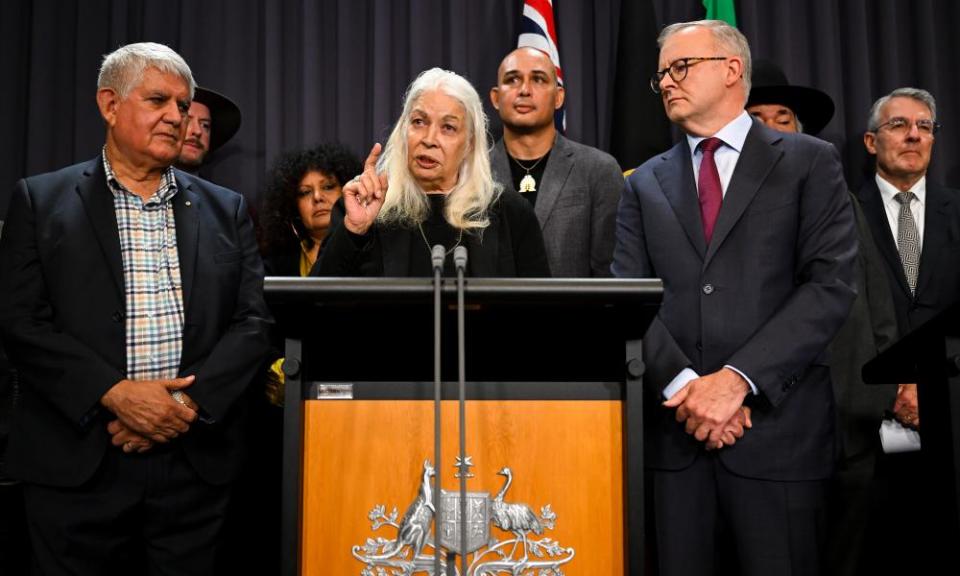The proposed voice to parliament question has been revealed. What happens next?

After months of anticipation and political debate, the Albanese government has revealed the proposed question and constitutional alteration for the Indigenous voice which will be voted on in Australia’s first referendum in 24 years.
The long-awaited details kickstart a process that will hurtle through further parliamentary debate, a committee inquiry and a potentially heated campaign ahead of a national vote in the final months of the year.
Related: All Australians own the constitution. Now we have the words to prove it | Kenneth Hayne
The prime minister, Anthony Albanese, said on Thursday there was no circumstance in which he would delay or defer the vote, declaring his government was “all in” on the push to enshrine a First Nations advisory body in the constitution.
“This is a modest request. I say to Australia: don’t miss it,” Albanese said.
What are we going to vote on?
Following years of inquiries, reports and constitutional processes, the government and its working group of Indigenous leaders announced the proposed referendum wording on Thursday.
When Australians vote at the referendum later this year, they’ll see a ballot paper with these words:
A Proposed Law: to alter the Constitution to recognise the First Peoples of Australia by establishing an Aboriginal and Torres Strait Islander Voice. Do you approve this proposed alteration?
The government is proposing adding a new chapter to the constitution, titled “Recognition of Aboriginal and Torres Strait Islander Peoples”. It would contain the following words:
In recognition of Aboriginal and Torres Strait Islander peoples as the First Peoples of Australia:
There shall be a body, to be called the Aboriginal and Torres Strait Islander Voice;
The Aboriginal and Torres Strait Islander Voice may make representations to the Parliament and the Executive Government of the Commonwealth on matters relating to Aboriginal and Torres Strait Islander peoples;
The Parliament shall, subject to this Constitution, have power to make laws with respect to matters relating to the Aboriginal and Torres Strait Islander Voice, including its composition, functions, powers and procedures.
What happens next?
A bill containing the proposals will be introduced to federal parliament next Thursday. It will be referred to a parliamentary committee, which will examine the wording of the bill.
The exact format and membership of the committee – which will run through April and May – has not yet been announced.
Asked Thursday if the proposed wording was final, Albanese said “of course it can be altered” through the committee, although he added: “I would take a lot of convincing before I would support any amendment.”
“This is quite clearly what we are going forward with,” he said.
The government hopes to pass the bill in June. Laws around referendums dictate that once a constitutional alteration bill is passed, the referendum must be held between three and six months later.
The government has already said it plans to hold the referendum between October and December, and it’s expected the vote will be held at the beginning of that period.
What will the voice look like?
The government maintains its longstanding position that many of the exact details of the voice – such as precisely how many members it will have – will be locked in after a successful referendum vote, after further consultation with Indigenous communities.
But on Thursday, the working group – an advisory body of Indigenous leaders put together by the government – released a broad set of design principles.
Those include that:
The voice’s membership would be chosen by Indigenous people in a way that suits local communities.
It would be representative of geography and gender.
It would have representatives from each state and territory, the Torres Strait Islands, remote areas and the mainland Torres Strait Islander population.
It would be accountable and transparent.
It would work alongside existing organisations, and not run any programs or have veto power.
Uluru statement co-chair Prof Megan Davis, a referendum working group member and UNSW constitutional academic, said the voice would have “an extraordinary impact” on the government’s work because it could make proactive suggestions.
“It doesn’t have to wait to be engaged by the parliament, it doesn’t have to wait to be consulted, it can make representations on its own initiative … it’s a very powerful mechanism,” she told Radio National on Thursday.
What are political parties saying?
Labor MPs and teal independents welcomed Thursday’s news while the Nationals, One Nation and United Australia Party reiterated their opposition.
Related: ‘I’m here to change the country’: Albanese launches an uncompromising Indigenous voice plan
Independents Allegra Spender, Zali Steggall, Monique Ryan and Zoe Daniel were among the first to back the amendment. Nationals leader David Littleproud said his party wasn’t changing their long-running opposition.
There’s still a question mark over the Liberal party. On Thursday, the Liberal leader, Peter Dutton, resisted declaring a position on the voice, again requesting more detail about how the body would work, despite the working group setting out pages of design principles.
Dutton also raised concerns about whether the voice’s representations would create the potential for court challenges, a concern raised by a small number of conservative critics, but which has been consistently rebuffed by numerous constitutional experts and the government.
In response to that concern, Davis said: “We’ve had the best legal minds in the country working on this … we believe very much we’ve got the balance right.”

 Yahoo News
Yahoo News 